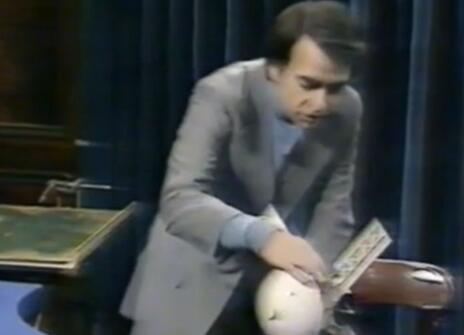Lecture 3 - The history of Mars
Cold, arid, and tens of millions of miles away from Earth, Mars has intrigued scientists for centuries. The existence of liquid on its surface was confirmed by NASA’s flyby mission, Mariner 4, in 1965, but the question of whether life exists on our neighbouring planet has remained a subject of much speculation.
In the 19th and 20th centuries, observers using only the naked eye and a telescope saw features on Mars which they interpreted as evidence for a dry but Earth-like climate, for vegetation which grew and decayed with the seasons, and for a great Martian canal network designed by a heroic but dying race of hydraulic engineers.
In the third of his CHRISTMAS LECTURES, Carl Sagan explores the mystery of the Red Planet. From its rocky craters to its polar ice caps, Carl describes our understanding of the geology and chemistry of Mars, revealing the discovery of its two moons, Phobos and Deimos, in 1877, and the bizarre one-time suggestion that these moons were artificial satellites launched by an ancient but not extinct Martian civilisation.
About the 1977 CHRISTMAS LECTURES
What exists beyond Earth? Over six Lectures presented in 1977, American astronomer and cosmologist Carl Sagan explores the vast expanse of space that surrounds the third planet from the Sun.
Life on Earth
Where at first we could only discern the size of our planet and some knowledge of its atmosphere and configuration, the evolution of planetary exploration has revealed not only intricate details of Earth’s climate and geology, but a multitude of stars and planets besides our own.
Beginning with a closer look at the world we inhabit, Carl explores of the diversity of life on our own planet and the building blocks behind it, before questioning whether the same organic chemistry is occurring on planets in the outer solar system.
The Red Planet
In Lecture three onwards, Carl takes a closer look at our neighbouring planet, Mars. From early interpretations of terrestrial life on its surface to the surprising discoveries made by NASA’s Viking Program, the Red Planet has become the focus of efforts to discern whether intelligent life exists elsewhere in the universe.
When Carl delivered his Lectures in the late 1970s, NASA had only just begun its Voyager program to the furthest planets in our solar system and no extra-solar planets were known to exist. Now, over three decades later, astronomers are looking at planets that lie beyond our solar system to ask the very same question we pondered over Mars: is there life out there?





